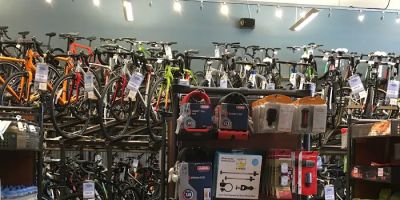
The Ultimate Ride: My Journey to Finding the Perfect Bikepacking Bike
1. The Spark That Started It All
I still remember the first time the idea hit me. I was sitting in a cramped office in Chicago, staring out the window at a world that felt far too small. I needed something different—something wild, unpredictable, liberating. That’s when I stumbled upon the term “bikepacking.” A cross between backpacking and long-distance cycling, it promised a kind of raw adventure I craved. One month later, I sold my car, quit my job, and set out to bikepack across the country. But first—I needed the right bike.

Mike's Bikes of Berkeley
1824 University Ave, Berkeley, CA 94703, USA
2. What Makes a Bike Ideal for Cross-Country Bikepacking?
Choosing a bike for bikepacking isn’t like picking your average commuter. You're trusting this machine with your gear, your safety, and thousands of miles of road, gravel, and sometimes trails. I spent countless hours researching, riding, and talking to fellow cyclists. Here's what I learned to look for:
- Frame Material: Steel for durability and comfort, aluminum for lightweight speed, and carbon for high performance—but usually with a higher price tag and less practicality for rugged, remote areas.
- Mounting Points: Essential for racks, water bottles, and gear. The more, the better.
- Tire Clearance: Bigger tires mean better comfort and traction, especially off-road.
- Geometry: A relaxed geometry keeps you comfortable during long hours in the saddle.
- Drivetrain: A wide gear range is crucial. You’ll thank yourself when you’re climbing those endless hills in Montana or the Ozarks.
3. My Top Picks for the Best Bikes for Bikepacking Across the Country
3.1. Surly Ogre
The Surly Ogre was my first love. Steel frame, incredible tire clearance, and mounting points for days. It’s basically a tank on two wheels. I took it through the Colorado Rockies, fully loaded, and it never flinched. Its ability to carry front and rear racks, a frame bag, and still remain balanced made it a beast for long stretches in isolated areas.

Mike's Bikes of Berkeley
1824 University Ave, Berkeley, CA 94703, USA
3.2. Salsa Fargo
Another legend in the bikepacking world. The Salsa Fargo features drop bars (which I personally love for varied hand positions), a comfortable steel frame, and tons of clearance for 29” tires. Its off-road pedigree gave me confidence through the gravel trails of Kansas and the rugged terrain in Utah. Paired with a set of bikepacking bags, it felt like an unstoppable machine.
3.3. Trek 520
A classic touring bike that’s stood the test of time. While it leans more toward traditional touring, it’s easily adaptable for bikepacking setups. I met a couple from Oregon riding matching 520s, and they had just crossed from Maine. They swore by its comfort and reliability. It’s especially great for riders who spend more time on paved roads with occasional detours.
3.4. Kona Sutra LTD
The Kona Sutra LTD was my second bike after retiring the Ogre. I was drawn in by its adventure-ready design—wider tires, drop bars, and a chromoly frame that absorbed shocks like a dream. It performed beautifully across the deserts of New Mexico, withstanding heat, dust, and constant vibration with ease.
4. Real Moments from the Road
One of the most memorable moments of my journey was in Idaho. My bike—fully loaded with camping gear, food, and water—took on a steep, rocky fire road. I was riding my Fargo at the time. The climb was brutal, but what amazed me was how the bike stayed responsive and agile. At the summit, I met another bikepacker from Germany. We shared stories over instant coffee and marveled at how these bikes had brought us to this shared experience in the middle of nowhere.
Not all moments were easy. In rural Kentucky, I had a derailleur issue that took hours to fix. That’s when I realized the importance of having a bike with accessible, replaceable components. I learned the hard way that high-end doesn’t always mean high-survivability.
5. Gear That Complements the Ride
The bike is just the beginning. Bikepacking success also depends on the right setup:
- Frame bags: Perfect for center weight distribution.
- Handlebar rolls: Great for sleeping bags or light clothing.
- Saddle packs: Hold your tools, spare tubes, or extra clothes.
- Hydration: Always carry more water than you think you’ll need.
- Lights and Navigation: A dynamo hub setup saved me in more than one late-night ride.
I got most of my gear recommendations and even my second bike from the experts at Healthy Cycling. They listened to my needs, matched me with the right setups, and helped me stay within budget. Their passion for adventure cycling is genuine, and it shows.
6. Final Thoughts from the Trail
If you’re dreaming of bikepacking across the country, start with the right bike. It doesn’t have to be the most expensive—it needs to be the most dependable for your route and your riding style. Test ride, talk to experienced riders, and don’t be afraid to get your hands dirty. Every mile will teach you something new, and the bike beneath you will become more than just a tool—it’ll become your partner in one of the greatest adventures of your life.
Whether you’re eyeing the Pacific Coast, the Great Divide, or a cross-country journey from coast to coast, there’s a perfect bikepacking rig out there for you. I found mine, and it changed everything.
Check out Healthy Cycling for expert advice and tailored recommendations. They helped me gear up for the ride of my life—and they can do the same for you.










